What’s new in gas processing technology
Detector tube system for gases, vapors
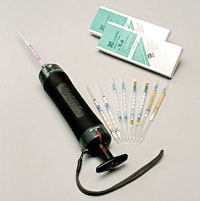 |
Nextteq’s line of Gastec pumps and detector tubes precisely measures gases and vapors in over 600 applications, making it useful for gas detection and measurement, as well as for detecting leaks and fugitive emissions.
Gastec solution detector tubes offer fast, economical, immediate measurement of trace chemicals in liquids. The tubes do not require mixing, calibration, equipment or accessories. A sensitive tube is placed in a sample of the target solution, giving accurate results in five minutes or less. The solution detector tubes can measure sulfide ion, ozone, chlorine and metals, such as mercury, chromium (VI) ion, iron ion, copper ion, zinc and nickel.
Flow nozzle for turbine facility
Primary Flow Signal has successfully delivered a 96-in. ASME PTC 19.5, throat-tapped flow nozzle for use within what is said to be the largest gas turbine validation facility in the world.
Once installed in the facility’s test stand, the flow nozzle will be subjected to simulations of real-world power connectivity and testing.
The flow nozzle gives the facility more accurate measurement of the high air flow output required for testing H-class gas turbines. This large-line-size nozzle features four equally spaced taps at the throat. These nozzles are available in flanged and weld-in styles. The interior surfaces are precision-machined for cylindricality and a hydraulically smooth surface. For weld-in flow nozzles, a code-recommended inspection port with a removable, contoured pin-oriented plug is available.
Control system with touchscreen display
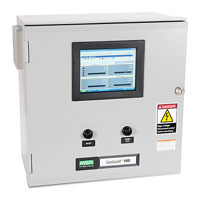 |
The GasGard 100 control system is a scalable, high-performance data acquisition/data-logging platform. The system is now available with a 10.4-in. TFT SVGA LED panel PC with resistive touchscreen display, providing intuitive operator control. The display’s fanless design enhances reliability, and it comes with an LED indicator on the front panel for power on/off, storage access and LAN active status.
The modular architecture of the GasGard 100 control system’s main module can manage one to six input/output modules on the backplane. Up to six GasGard controllers can be networked together to create a complete system.
With this capability, each GasGard 100 controller can serve as a measurement node, monitoring a subgroup of sensors, where all communicate back to a master GasGard controller. This setup can minimize the length of wire and conduit typically necessary for adequately monitoring a facility.
Open Ethernet connectivity, with web-based configuration and data-monitoring functions, allows GasGard 100 controllers to handle a wide range of monitoring and historical logging functions. Users can see real-time trends with a web browser from any PC without the need for specialized software.
Reliable approach to reformer flue gas tunnels
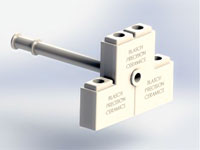 |
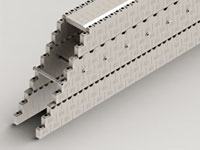 |
Blasch Precision Ceramics Inc. offers a new approach to primary reformer flue gas tunnels with its StaBlox Tunnel System. The system enables rapid, simple installation, and it offers a higher level of reliability with customizable interlocking blocks and mortar-free expansion joints.
Unlike traditional reformer flue gas tunnels, which can fail as a result of multiple thermal cycles on the mortared components and incorrect accommodation for expansion due to thermal growth, Blasch Precision Ceramics has eliminated the guesswork from its StaBlox Tunnel System. The same base material and distributed expansion technology behind the StaBlox system has been supplied by Blasch in several other high-temperature combustion applications.
Due to the geometry of the blocks in the base, walls and customized structural lid of the Blasch StaBlox Tunnel System, installation is reduced to less than half of the present installation time, with less labor required and no mortar joints.
Low-carbon gas fuels for California
A new study by Energy Environmental Economics (E3) Consulting suggests that low-carbon gas fuels are a viable option for meeting California’s greenhouse gas (GHG) reduction goals.
Low-carbon gas fuels, or “decarbonized gas,” refer to gaseous fuels with a net zero, or very low, GHG impact on the climate. These fuels include biogas, hydrogen and renewable synthetic gases produced with low-lifecycle GHG emission approaches.
The report compares two “technology pathway” scenarios: an electrification scenario, where all energy end uses are electrified and powered by renewable electricity; and a multi-energy framework, where both electricity and decarbonized gas fuels play significant roles.
The study concludes that a technology pathway for decarbonized gas could help meet the state’s GHG reduction goals, and that it may be easier and less costly to implement in some sectors than a high-electrification strategy.
Software system for gas gathering assets
Tall Oak Midstream LLC has “gone live” with Energy Solutions International’s (ESI’s) new GasStream software. Following a successful 12-week pilot, the company entered into a hosted, subscription-based agreement with ESI for full commercial use of the GasStream software for all of its natural gas gathering and processing assets. Developed for midstream companies using state-of-the-art technology, the GasStream software is ESI’s advanced transaction and volumetric accounting system.
ESI offers a hosted, cloud-based solution that can be accessed from office computers and from phones or tablets in the field and at home.
The GasStream software is a transaction and volumetric accounting system for midstream natural gas gathering and processing. It tracks and manages contracts, nominations and deliveries, as well as ownership of the raw wet gas from the natural gas wellhead through the processing plant, along with dry gas and related products.
GasStream uses .NET and HTML 5 technology, making it secure and mobile-friendly. The product can be implemented as a traditional installation at the customer’s site, or it can be hosted and delivered via cloud computing through a monthly subscription service provided by DYONYX, ESI’s preferred global hosting partner.
www.talloakmidstream.com, www.energy-solutions.com
CO2-capture solvent testing
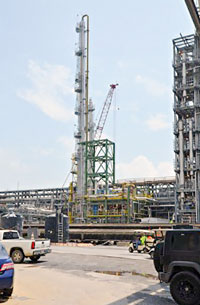 |
Pilot-scale testing of an advanced technology for economically capturing carbon dioxide (CO2) from flue gas has begun at the National Carbon Capture Center (NCCC) in Wilsonville, Alabama. Under a cooperative agreement with the US Energy Department’s National Energy Technology Laboratory (NETL), Linde LLC is operating a Nominal 1-MWe pilot plant (pictured) that is expected to capture 30 tpd of CO2. Cost-effective carbon capture and storage from fossil-based power generation is a critical component of national efforts to mitigate climate change.
Testing at the pilot plant will validate performance of the Linde-BASF CO2-capture technology on actual coal-derived flue gas. The NCCC includes a post-combustion carbon-capture facility that allows testing and integration of advanced CO2-capture technologies using flue gas from Alabama Power’s Gaston power plant Unit 5—an 880-MW pulverized coal unit.
Successful testing will be a major step toward achieving the overall Energy Department goal of 90% CO2 capture with 95% CO2 purity at a cost of $40/metric ton of CO2 captured.
The technology being tested integrates BASF’s advanced aqueous amine-based solvent (OASE blue) and process technology with novel CO2-capture process and engineering innovations being developed by Linde.
OASE blue chemically absorbs CO2 from the flue gas at a relatively low temperature in the absorption column. The CO2-rich solvent is then transferred to a stripping column, where steam is added to heat the solvent, reversing the chemical reaction and releasing high-purity CO2 for compression and pipeline transport. The CO2-lean solvent is recycled back to the absorption column for additional CO2 capture.
The planned 18-month test program consists of three phases: initial startup and operation with flue gas and solvent recirculation, parametric testing and long-duration testing for a minimum of 60 days.
Following pilot testing, Linde and BASF will jointly pursue opportunities for larger-scale testing,
leading to full-scale commercialization in the 2025 timeframe.
Module totals flowrates to address flaring
Spurred by the growth of hydraulic fracturing technology within the US, flare gas regulations have become tighter. SignalFire Telemetry’s Totalizer Module works with analog or digital flowmeters to provide instantaneous, total and daily gas flow information.
With a built-in, user-configurable, real-time clock, the wireless module stores the last 30 daily total flows. Data can be accessed wirelessly or locally.
The module offers instantaneous and totalized flowrates, 4-20 analog input scales to flow velocity (1 V–5 V available on request), a digital input interface (6 VDC–36 VDC), 32 days of history available via a Modbus interface, very low power consumption, relay output for local control and a DIN rail mount.




Comments